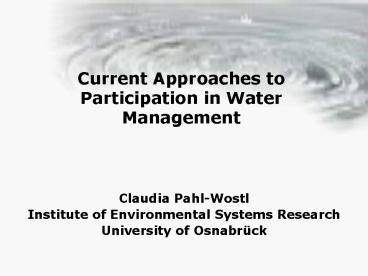Current Approaches to Participation in Water Management - PowerPoint PPT Presentation
1 / 24
Title:
Current Approaches to Participation in Water Management
Description:
Uncertainties in climate change, economic development - flexible ... Mental Models: Hexagon Method. Cause-effect relationships. Household. Water- technology ... – PowerPoint PPT presentation
Number of Views:33
Avg rating:3.0/5.0
Title: Current Approaches to Participation in Water Management
1
Current Approaches toParticipation in Water
Management
- Claudia Pahl-Wostl
- Institute of Environmental Systems Research
- University of Osnabrück
2
Challenges for Water Management
- Technological tradition.
- Based on ability to predict and quantify risks
- Human behaviour as boundary condition.
- Uncertainties in climate change, economic
development -gt flexible integrated management
schemes. - The Human Dimension gains in importance.
3
Some activities at European Level FIRMA
HarmoniCOP
4
HarmoniCOP HARMONIzing COllaborative Planning
5
Implementation Needs
- Integrated management straegies require
participatory approaches - to deal with different valuation schemes
- to mediate conflicts of interest
- to combine ethical considerations with formal
approaches in risk assessment - NEED FOR SOCIAL LEARNING!
6
Social learning in water management
- Social learning is required for all stakeholders
to deal with different interests and points of
view and to collectively manage their river basin
in a sustainable way.
7
Elements of Social Learning
- Build up shared problem perception in a group of
actors. - Build trust for self-reflection - recognition of
individual mental frames and images and how they
pertain to decision making. - Recognize mutual dependencies and interactions.
- Reflect on assumptions about the dynamics and
cause-effect relationships in the basin. - Reflect on subjective valuation schemes.
- Engage in collective decision- and learning
processes.
8
PUBLIC AND STAKEHOLDER PARTICIPATION
Public and stakeholder participation refers to
the active involvement of individual citizens,
individual companies, public interest groups and
economic interest groups in decision making.
Communication and information flows are
important aspects of PP. Information and
communication tools are of major importance.
9
SOCIAL LEARNING
- It is argued here that transformation and
change, and processes of social learning are of
major importance if the sustainability of current
resource management regimes is to be improved. - However, the theoretical base for social
learning is still fragmented. This must be
attributed to the fact that an interdisciplinary,
system-oriented approach is missing in the social
sciences.
10
SOCIAL LEARNING
- Social learning is based on the idea that social
change requires - critical self-reflection,
- the development of participatory, multi-scale,
democratic processes, - reflexive capabilities of individuals and
societies, - the capacity of social movements to shape the
political and economic boundary conditions
towards improvement of the current situation.
11
SOCIAL LEARNING
- Social learning with respect to sustainable
development is based on the participatory
processes of social change and societal
transformations with the aim of - making clear the goals and stakes that are
involved in transformation processes, - achieve better (because democratic) solutions to
environmental problems, - thus fostering the implementation of measures
that have been agreed upon, - and better manage conflicts.
12
ELEMENTS OF SOCIAL LEARNING 1
- Processes of social learning should contain the
following elements - Build up a shared problem perception in a group
of actors, in particular when the problem is
largely ill-defined (this does not imply
consensus building). - Build trust as base for a critical
self-reflection, which implies recognition of
individual mental frames and images and how they
pertain to decision making.
13
ELEMENTS OF SOCIAL LEARNING 2
- Recognize mutual dependencies and interactions in
the actor network. - Reflect on assumptions about the dynamics and
cause-effect relationships in the system to be
managed. - Reflect on subjective valuation schemes.
- Engage in collective decision- and learning
processes (this may include the development of
new management strategies, and the introduction
of new formal and informal rules).
14
Stakeholder groups in the development and use
of models
Participatory Model developers
Practitioners
Model developers
Concept for the use of models in river basin
management Expectations on the needs of
endusers and how models should be applied
Information needs Policy problems Implementation
Questions Expectations about Models /
Information
Conceptual approaches on participatory processes
and the role of information/models Experience on
success and failure
15
FIRMA Freshwater Integrated Resource Management
with Agents
16
Models and information in processes of social
learning
SOFT
HARD
17
Participatory agent based social simulation
- Actors participate in the model development
process - Actors learn and may change the rules under which
they operate when confronted with a
representation of their system. - Modeling to learn and not to predict!
18
LockIn- Effects
preventing change.
19
Our Methodological Approach to explore innovation
- Elicit domain knowledge on decision making
processes with experts (thesis as input) - Design participatory process with stakeholder
groups and citizens - Develop an agent based model in a participatory
setting - Use model moderation to establish a shared
problem perception and foster processes of social
learning
20
Mental Models (Methodological development by
Matthew Hare)
21
Mental Models Hexagon Method
- Cause-effect relationships
Household Water- technology
Water Demand
environmental awareness
Water- bill
22
Modell Structure
System Indicators Water demand Water supply Water
quality
23
Social Learning in Actors platform
24
Some results
- Role playing game and model with qualitative
dynamics was very useful to challenge current
thinking, foster innovation and clarify thoughts
about the role of different stakeholder groups. - One major product was a memo of understanding
with results of the whole process. - Promising approach to explore the potential and
implement new management strategies.































